Frog Culture in Japanese History
Safe Return Frog Traffic Safety Charm | Renkyuji Temple, Chiba
In Japanese culture, frogs (kaeru) are not merely amphibians but creatures with rich symbolism and cultural significance. In Japan, a country of water and rice cultivation, frogs have been revered as symbols of abundant harvests. Additionally, the word "kaeru" shares pronunciation with "to return," "to exchange," and "to transform," making frogs appear in numerous folk beliefs and artistic works due to these auspicious word associations.
1. Water and Rice Cultivation — Shinto and Frogs
Frogs that begin croaking in unison during rice planting season were seen as heralds of water-filled paddies and bountiful harvests. In folk beliefs, they were considered attendants of the "rice field deity = water deity," and in some regions, frogs were enshrined during rain prayers. As water spirits, frogs were sometimes viewed as originating from the same source as kappa (water imps) and snake deities, with traces of this belief remaining in the water deity legends of Aso Shrine in Kumamoto.
The dramatic metamorphosis from tadpole to four-limbed land creature overlapped with imagery of "death and rebirth," giving frogs the perceived power to cleanse impurities. This later developed into talismans for "healing illness" and "rejuvenation."
2. Word Spirit — The Multiple Symbolism of "Kaeru"
The homophony of kaeru (frog) with kaeru (to return/exchange/transform) was treated as having spiritual power, leading to various talismans imbued with multiple wishes:
- Safe return (traffic safety and travel protection)
- Return of lost money (financial fortune)
- Return of good fortune (inviting prosperity)
- Rejuvenation (health and longevity)
The "frog charm" of Juban Inari Shrine and the traffic safety charm of Shirasaki Hachiman Shrine are typical examples. The kanji for "frog" (蛙) consists of the "insect" radical (虫) + "圭," indicating "a sacred-voiced insect living in wetlands." The ancient word "kawazu" was used distinctively in poetry. The concept of frogs as beings that emit sounds and "change" their surroundings was accepted as having magical power beyond wordplay.
In dry landscape gardens and strolling gardens, stone carvings of frogs are placed as auspicious objects that "invite fortune" and evoke a sense of water. Granite mother-and-child frog statues and fossil stone sculptures are common, evoking seasonal awareness and life cycles for the viewer.
3. Visual Arts — From Garden Stones to Netsuke

Frogs wrestling in the Choju-jinbutsu-giga (12th century)
The scene in the Choju-jinbutsu-giga (Scrolls of Frolicking Animals) depicting rabbits and frogs wrestling is the prototype of "animal knights" humorously reflecting human society. This tradition continued in later caricatures and toys of frog warriors and frog knights. During the Edo period, netsuke (small carved toggles) featuring frogs on sandals were carried as protective charms for "safe return from travel." Caricatures from Kuniyoshi's school depicted the "three-way deadlock" of snake-frog-slug and frog battles, which became popular as parodies of warrior prints.

Wooden netsuke 'Frog on a Leaf' (19th century)
4. Storytelling — From Poetry to Games
The Man'yoshu (Collection of Ten Thousand Leaves) includes over 20 poems about "kawazu" (frogs), composing the clear call of the Kajika frog as the "sound of life." The preface to Kana poetry in the Heian period also highlights frogs, stating "hearing the nightingale singing in flowers and the frog dwelling in water..." with Basho's "old pond..." haiku representing the pinnacle of this tradition. The croaking of frogs was a seasonal word for spring, serving as a poetic device for seasonal change and rebirth.
An old pond
A frog jumps in
Sound of water
— Matsuo Basho
The swordsman "Frog" appearing in Square's RPG "Chrono Trigger" is a modern example where Arthurian knight imagery intersects with Japanese anthropomorphic frog culture. The story of bravery and transformation (curse→revival) follows the original symbolism of "kaeru."
Summary
- Water and Rice Cultivation — Connected to Shinto water deity beliefs, protecting abundant harvests and rain prayers.
- Word Spirit — The multiple meanings of "kaeru" invite various wishes from traffic safety to financial fortune.
- Visual Arts — Transformed into garden stones, netsuke, and caricatures, conveying both humor and prayer.
- Storytelling — Continuing from classical poetry to modern games as a symbol of "transformation and return."
Looking at it this way, we can see that in Japanese culture, the frog has continued to jump freely through rituals, arts, and entertainment as an auspicious symbol embodying "circulating water and life" and "change and return."